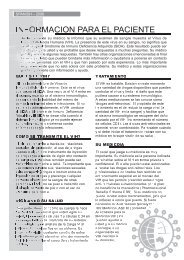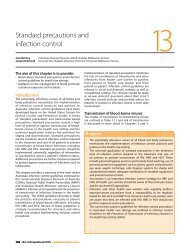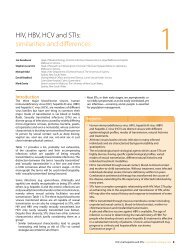B Positive – all you wanted to know about - ASHM
B Positive – all you wanted to know about - ASHM
B Positive – all you wanted to know about - ASHM
Create successful ePaper yourself
Turn your PDF publications into a flip-book with our unique Google optimized e-Paper software.
Executive Summary<br />
variable course of chronic infection. noninvasive<br />
methods of fibrosis assessment,<br />
such as algorithms based on biochemical<br />
markers in serum, or the use of non-invasive<br />
scans, such as the fibroscan® technique <strong>to</strong><br />
quantify hepatic fibrosis, are currently under<br />
assessment and may become a useful adjunct<br />
<strong>to</strong> (and in some cases avoid the need for) liver<br />
biopsies in the future (chapter 3: Hepatitis b<br />
virus testing and interpreting test results).<br />
as virological tests for the diagnosis and<br />
moni<strong>to</strong>ring of hepatitis b have improved, the<br />
goalposts for treatment continue <strong>to</strong> change.<br />
indications for treatment are discussed in<br />
chapter 7: treatment of chronic hepatitis b<br />
virus infection. treatment should currently be<br />
considered for patients in the immune active<br />
phase of chronic hepatitis b (high HbV dna<br />
> 20,000 iu/mL, elevated aLt and fibrosis or<br />
inflammation on biopsy), but not for patients<br />
in the immune <strong>to</strong>lerant phase (high HbV dna<br />
> 20,000 iu/mL and normal aLt). treatment is<br />
also recommended for patients with pre-core<br />
mutant disease (Hbeag negative, elevated<br />
aLt and HbV dna > 2000 iu/mL) and should<br />
be considered in <strong>all</strong> patients with cirrhosis<br />
and any level of detectable HbV dna. the<br />
primary goal of treatment is virological<br />
suppression (particularly in the Hbeag<br />
negative group), but other goals include<br />
Hbeag seroconversion (in Hbeag-positive<br />
patients), and his<strong>to</strong>logical improvement.<br />
these goals are often related, but may occur<br />
independently. the therapeutic endpoint<br />
is Hbsag seroconversion, but this outcome<br />
occurs infrequently.<br />
HbV treatment is based around two main<br />
classes of therapy: immunomodulating<br />
agents (interferon based-therapy) and<br />
direct antiviral agents. standard interferon<br />
therapy has now been replaced by the use<br />
of pegylated interferon. therapy is given<br />
by weekly subcutaneous injection for a<br />
fixed duration of 12 months and results in<br />
Hbeag seroconversion in just under a third<br />
of Hbeag-positive patients. it may also have<br />
a role in some Hbeag-negative patients in<br />
whom it is able <strong>to</strong> induce sustained viral<br />
control. Pegylated interferon has a significant<br />
10 b <strong>Positive</strong> <strong>–</strong> <strong>all</strong> <strong>you</strong> <strong>wanted</strong> <strong>to</strong> <strong>know</strong> <strong>about</strong> hepatitis b: a guide for primary care providers<br />
side effect profile and is contra-indicated in<br />
decompensated cirrhosis.<br />
the other mainstay of HbV treatment is the use<br />
of antiviral agents, an increasing number of<br />
which is now available. Lamivudine has been<br />
used for the treatment of chronic hepatitis b<br />
infection for many years. While active against<br />
HbV, it results in an increasing rate of drug<br />
resistance when used as monotherapy for any<br />
length of time. additional potent anti-HbV<br />
agents now licensed for use in australia are<br />
entecavir and adefovir; other agents not yet<br />
available here include telbivudine, tenofovir<br />
and emtricitabine. the use of these agents is<br />
discussed in detail in chapter 7: treatment of<br />
chronic hepatitis b virus infection. a major<br />
concern with the use of any antiviral agent is<br />
the development of drug resistance. in chronic<br />
hepatitis b, drug resistance may lead <strong>to</strong> viral<br />
rebound, hepatic flare and, in patients with<br />
cirrhosis, potential hepatic decompensation.<br />
an understanding of the mechanisms of<br />
HbV resistance development will guide the<br />
appropriate use and combination of these<br />
agents in the future (chapter 2: Virology: viral<br />
replication and drug resistance).<br />
a number of special situations exist in which<br />
the management and therapeutic options<br />
for HbV may be more complex than usual.<br />
these include the management of pregnant<br />
women, children and people who have a<br />
hepatitis c, hepatitis d (delta) or human<br />
immunodeficiency virus (HiV) co-infection<br />
(chapter 10: Managing hepatitis b virus<br />
infection in complex situations). in patients<br />
with HiV co-infection, a number of antiviral<br />
agents have activity against both HbV and<br />
HiV (lamivudine, emtricitabine, adefovir,<br />
tenofovir and entecavir) and thus their<br />
effect on both viruses must be carefully<br />
considered before treatment for either is<br />
initiated. another group in need of careful<br />
management is that of people with HbV<br />
infection undergoing immunosuppressive<br />
therapy (including cancer chemotherapy),<br />
transplant recipients and patients treated<br />
with immunosuppressive agents for au<strong>to</strong>immune<br />
disease, steroids, or antimonoclonal<br />
agents such as rituximab. the aggressive






